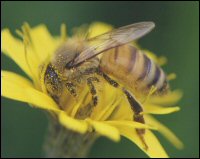

Honeybees may be one of the best known insects, providing humans with honey that we use to eat and cook with. Did you know that honeybees divide up their work? You can often tell what job a bee has in the hive by how it looks. Male drones are about 1/2 an inch long, roundish, and have large eyes. Female workers are about 1/4 inch long, making them smaller than the other bees. The queen bee is the largest and slightly larger than the others--up to 3/4 of an inch long. She also has the smallest eyes and the largest abdomen. But all honeybees are reddish-brown with yellow stripes on their abdomen. They have a black head, transparant wings, and long black antennae. Honeybees carry a pollen sac on their back legs.
The honeybee is seen throughout the world in meadows, open woods, and gardens. They make their hives in hollow trees or in hives kept by human beekeepers. Worker bees spend their days looking for pollen in all kinds of flowers. Adults drink this nectar and eat the honey that they make.
Honeybees are very social creatures and have a complex organizational structure. The bees all focus on keeping their queen alive and mating for her entire life--almost 5 years. She is the only bee to lay eggs--up to 80,000 total. Most of these will be worker bees who collect pollen, make the honey, and maintain the hive. The workers also feed the queen 'royal jelly' all day and tend the young larvae. Some of the larvae are marked to be queens as adults--they get extra-special treatment! When the new queens are mature in the late summer, the old queen will leave with some of her workers to start a new hive. The young queens fight among themselves until one is dominant. She will kill all the others and take over the hive.